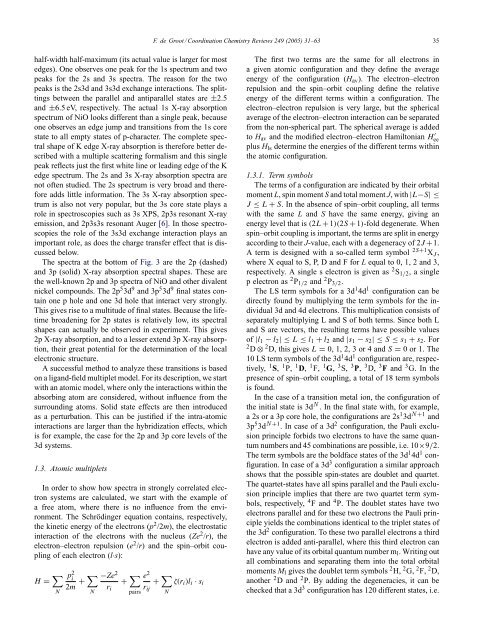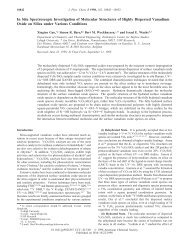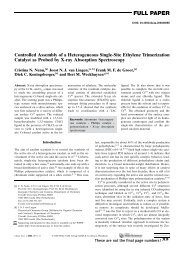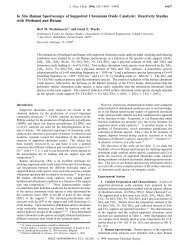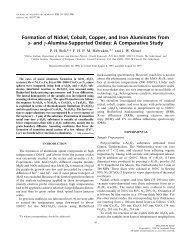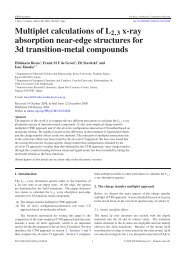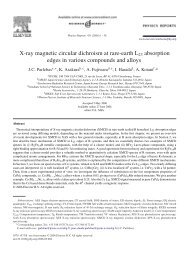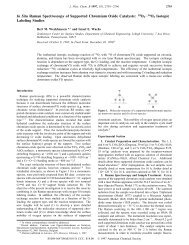Multiplet Effects in X-ray Absorption - Inorganic Chemistry and ...
Multiplet Effects in X-ray Absorption - Inorganic Chemistry and ...
Multiplet Effects in X-ray Absorption - Inorganic Chemistry and ...
You also want an ePaper? Increase the reach of your titles
YUMPU automatically turns print PDFs into web optimized ePapers that Google loves.
F. de Groot / Coord<strong>in</strong>ation <strong>Chemistry</strong> Reviews 249 (2005) 31–63 35half-width half-maximum (its actual value is larger for mostedges). One observes one peak for the 1s spectrum <strong>and</strong> twopeaks for the 2s <strong>and</strong> 3s spectra. The reason for the twopeaks is the 2s3d <strong>and</strong> 3s3d exchange <strong>in</strong>teractions. The splitt<strong>in</strong>gsbetween the parallel <strong>and</strong> antiparallel states are ±2.5<strong>and</strong> ±6.5 eV, respectively. The actual 1s X-<strong>ray</strong> absorptionspectrum of NiO looks different than a s<strong>in</strong>gle peak, becauseone observes an edge jump <strong>and</strong> transitions from the 1s corestate to all empty states of p-character. The complete spectralshape of K edge X-<strong>ray</strong> absorption is therefore better describedwith a multiple scatter<strong>in</strong>g formalism <strong>and</strong> this s<strong>in</strong>glepeak reflects just the first white l<strong>in</strong>e or lead<strong>in</strong>g edge of the Kedge spectrum. The 2s <strong>and</strong> 3s X-<strong>ray</strong> absorption spectra arenot often studied. The 2s spectrum is very broad <strong>and</strong> thereforeadds little <strong>in</strong>formation. The 3s X-<strong>ray</strong> absorption spectrumis also not very popular, but the 3s core state plays arole <strong>in</strong> spectroscopies such as 3s XPS, 2p3s resonant X-<strong>ray</strong>emission, <strong>and</strong> 2p3s3s resonant Auger [6]. In those spectroscopiesthe role of the 3s3d exchange <strong>in</strong>teraction plays animportant role, as does the charge transfer effect that is discussedbelow.The spectra at the bottom of Fig. 3 are the 2p (dashed)<strong>and</strong> 3p (solid) X-<strong>ray</strong> absorption spectral shapes. These arethe well-known 2p <strong>and</strong> 3p spectra of NiO <strong>and</strong> other divalentnickel compounds. The 2p 5 3d 9 <strong>and</strong> 3p 5 3d 9 f<strong>in</strong>al states conta<strong>in</strong>one p hole <strong>and</strong> one 3d hole that <strong>in</strong>teract very strongly.This gives rise to a multitude of f<strong>in</strong>al states. Because the lifetimebroaden<strong>in</strong>g for 2p states is relatively low, its spectralshapes can actually be observed <strong>in</strong> experiment. This gives2p X-<strong>ray</strong> absorption, <strong>and</strong> to a lesser extend 3p X-<strong>ray</strong> absorption,their great potential for the determ<strong>in</strong>ation of the localelectronic structure.A successful method to analyze these transitions is basedon a lig<strong>and</strong>-field multiplet model. For its description, we startwith an atomic model, where only the <strong>in</strong>teractions with<strong>in</strong> theabsorb<strong>in</strong>g atom are considered, without <strong>in</strong>fluence from thesurround<strong>in</strong>g atoms. Solid state effects are then <strong>in</strong>troducedas a perturbation. This can be justified if the <strong>in</strong>tra-atomic<strong>in</strong>teractions are larger than the hybridization effects, whichis for example, the case for the 2p <strong>and</strong> 3p core levels of the3d systems.1.3. Atomic multipletsIn order to show how spectra <strong>in</strong> strongly correlated electronsystems are calculated, we start with the example ofa free atom, where there is no <strong>in</strong>fluence from the environment.The Schröd<strong>in</strong>ger equation conta<strong>in</strong>s, respectively,the k<strong>in</strong>etic energy of the electrons (p 2 /2m), the electrostatic<strong>in</strong>teraction of the electrons with the nucleus (Ze 2 /r), theelectron–electron repulsion (e 2 /r) <strong>and</strong> the sp<strong>in</strong>–orbit coupl<strong>in</strong>gof each electron (l·s):H = ∑ Np 2 i2m + ∑ N−Ze 2+ ∑ e 2+ ∑ ζ(r i )l i · s ir i r ijpairs NThe first two terms are the same for all electrons <strong>in</strong>a given atomic configuration <strong>and</strong> they def<strong>in</strong>e the averageenergy of the configuration (H av ). The electron–electronrepulsion <strong>and</strong> the sp<strong>in</strong>–orbit coupl<strong>in</strong>g def<strong>in</strong>e the relativeenergy of the different terms with<strong>in</strong> a configuration. Theelectron–electron repulsion is very large, but the sphericalaverage of the electron–electron <strong>in</strong>teraction can be separatedfrom the non-spherical part. The spherical average is addedto H av <strong>and</strong> the modified electron–electron Hamiltonian H ′ eeplus H ls determ<strong>in</strong>e the energies of the different terms with<strong>in</strong>the atomic configuration.1.3.1. Term symbolsThe terms of a configuration are <strong>in</strong>dicated by their orbitalmoment L, sp<strong>in</strong> moment S <strong>and</strong> total moment J, with |L−S| ≤J ≤ L + S. In the absence of sp<strong>in</strong>–orbit coupl<strong>in</strong>g, all termswith the same L <strong>and</strong> S have the same energy, giv<strong>in</strong>g anenergy level that is (2L + 1)(2S + 1)-fold degenerate. Whensp<strong>in</strong>–orbit coupl<strong>in</strong>g is important, the terms are split <strong>in</strong> energyaccord<strong>in</strong>g to their J-value, each with a degeneracy of 2J +1.A term is designed with a so-called term symbol 2S+1 X J ,where X equal to S, P, D <strong>and</strong> F for L equal to 0, 1, 2 <strong>and</strong> 3,respectively. A s<strong>in</strong>gle s electron is given as 2 S 1/2 , a s<strong>in</strong>glep electron as 2 P 1/2 <strong>and</strong> 2 P 3/2 .The LS term symbols for a 3d 1 4d 1 configuration can bedirectly found by multiply<strong>in</strong>g the term symbols for the <strong>in</strong>dividual3d <strong>and</strong> 4d electrons. This multiplication consists ofseparately multiply<strong>in</strong>g L <strong>and</strong> S of both terms. S<strong>in</strong>ce both L<strong>and</strong> S are vectors, the result<strong>in</strong>g terms have possible valuesof |l 1 − l 2 |≤L ≤ l 1 + l 2 <strong>and</strong> |s 1 − s 2 |≤S ≤ s 1 + s 2 .For2 D ⊗ 2 D, this gives L = 0, 1, 2, 3 or 4 <strong>and</strong> S = 0or1.The10 LS term symbols of the 3d 1 4d 1 configuration are, respectively,1 S, 1 P, 1 D, 1 F, 1 G, 3 S, 3 P, 3 D, 3 F <strong>and</strong> 3 G. In thepresence of sp<strong>in</strong>–orbit coupl<strong>in</strong>g, a total of 18 term symbolsis found.In the case of a transition metal ion, the configuration ofthe <strong>in</strong>itial state is 3d N . In the f<strong>in</strong>al state with, for example,a 2s or a 3p core hole, the configurations are 2s 1 3d N +1 <strong>and</strong>3p 5 3d N +1 . In case of a 3d 2 configuration, the Pauli exclusionpr<strong>in</strong>ciple forbids two electrons to have the same quantumnumbers <strong>and</strong> 45 comb<strong>in</strong>ations are possible, i.e. 10×9/2.The term symbols are the boldface states of the 3d 1 4d 1 configuration.In case of a 3d 3 configuration a similar approachshows that the possible sp<strong>in</strong>-states are doublet <strong>and</strong> quartet.The quartet-states have all sp<strong>in</strong>s parallel <strong>and</strong> the Pauli exclusionpr<strong>in</strong>ciple implies that there are two quartet term symbols,respectively, 4 F <strong>and</strong> 4 P. The doublet states have twoelectrons parallel <strong>and</strong> for these two electrons the Pauli pr<strong>in</strong>cipleyields the comb<strong>in</strong>ations identical to the triplet states ofthe 3d 2 configuration. To these two parallel electrons a thirdelectron is added anti-parallel, where this third electron canhave any value of its orbital quantum number m l . Writ<strong>in</strong>g outall comb<strong>in</strong>ations <strong>and</strong> separat<strong>in</strong>g them <strong>in</strong>to the total orbitalmoments M l gives the doublet term symbols 2 H, 2 G, 2 F, 2 D,another 2 D <strong>and</strong> 2 P. By add<strong>in</strong>g the degeneracies, it can bechecked that a 3d 3 configuration has 120 different states, i.e.


